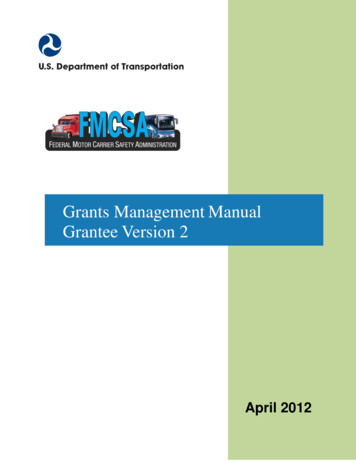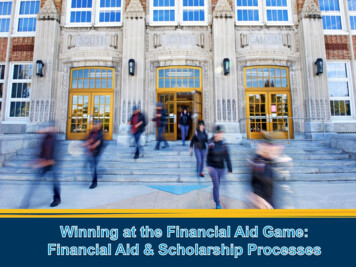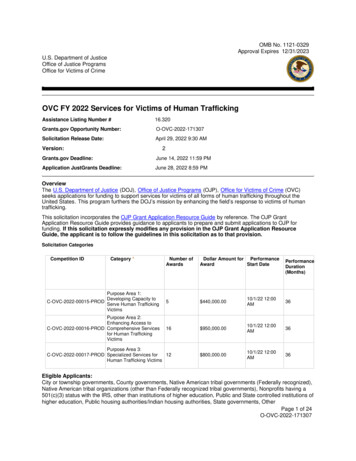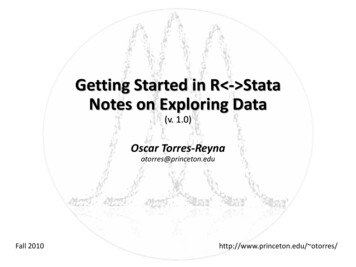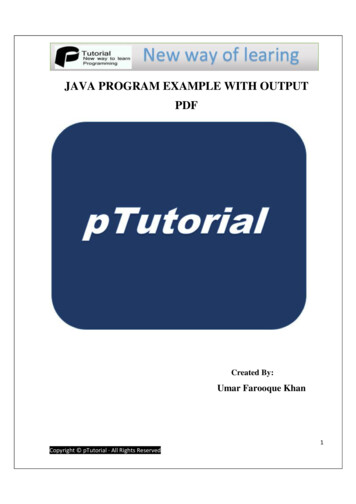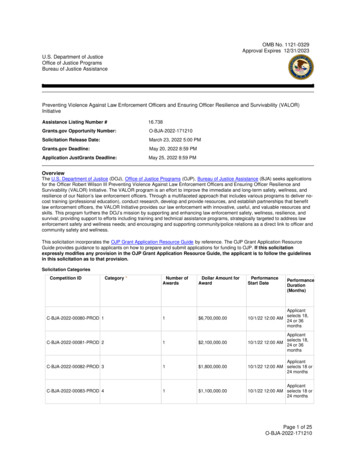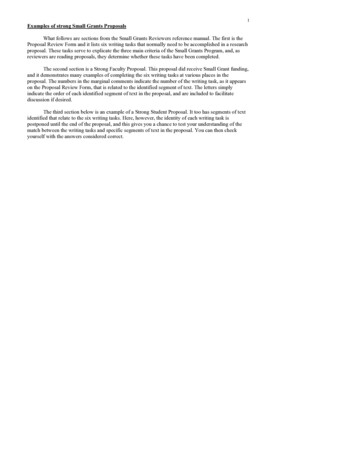
Transcription
1Examples of strong Small Grants ProposalsWhat follows are sections from the Small Grants Reviewers reference manual. The first is theProposal Review Form and it lists six writing tasks that normally need to be accomplished in a researchproposal. These tasks serve to explicate the three main criteria of the Small Grants Program, and, asreviewers are reading proposals, they determine whether these tasks have been completed.The second section is a Strong Faculty Proposal. This proposal did receive Small Grant funding,and it demonstrates many examples of completing the six writing tasks at various places in theproposal. The numbers in the marginal comments indicate the number of the writing task, as it appearson the Proposal Review Form, that is related to the identified segment of text. The letters simplyindicate the order of each identified segment of text in the proposal, and are included to facilitatediscussion if desired.The third section below is an example of a Strong Student Proposal. It too has segments of textidentified that relate to the six writing tasks. Here, however, the identity of each writing task ispostponed until the end of the proposal, and this gives you a chance to test your understanding of thematch between the writing tasks and specific segments of text in the proposal. You can then checkyourself with the answers considered correct.
2Small Grants ProgramProposal Review FormProject Title:Investigator:Reviewer: Date Needed:Indicate the need for a response from the investigator by circling one of the options(None, Some, or Significant) next to the task. Where a response is called for, providenarrative comments that guide the investigator. Select one Summary JudgmentRecommendation from among those at the bottom of the page and forward your decisionalong with any narrative comments. Keep this form for your records.TasksNeed for response(circle one)Criterion 1: Clear research question or purpose1234Clearly states a narrowed research question or purpose that is None Some Significantmaintained throughout the proposal.Defines terms needed to understand the research question orNone Some Significantits significance.Criterion 2: Significant research questionPresents literature, theory, or logic that forms the context ofthe question and gives rise to the statement of significance.Explains how the project will contribute to the field.None Some SignificantNone Some SignificantCriterion 3: Effective research methods56Demonstrates that the methodology addresses the researchquestion by (a) defining/delineating key elements of themethodology, (b) explaining their logic, and/or (c) defendingtheir quality or effective prior use.Explains the feasibility of carrying out the research methods.1 Fund in present form.None Some SignificantNone Some SignificantSummary Funding Recommendation(Circle a single option)2 Fund pending response3 Unable to determine funding withoutfrom investigator.review of a re-submitted proposal.
3Manual Section II: A Strong Faculty ProposalNotation system used in annotations1. Marginal comments designate the beginning of segments, and, for extendedsegments, their ends.2. Letters serve to identify each segment within the series of segments in theproposal.3. Numbers indicate the criterion-related writing task that the segmentaddresses, as indicated on the Proposal Review Form (Preceding page).4. Within the body of the text, each target segment is bounded at thebeginning and end by the same letter-number combination.A.1Effect of Tail Loss on Swimming and Running Abilities of Semi-Aquatic andleonard.kellyN 12/1/04 1:38 PMComment: A.1Terrestrial Plethodontid SalamandersA.1Project SummaryB.2Tail autotomy is the ability to lose the tail when grasped by a predator. B.2C.4Although such tail loss has an immediate survival benefit, it might subsequentlyleonard.kellyN 12/1/04 1:38 PMComment: B.2leonard.kellyN 12/1/04 1:38 PMComment: C.4reduce fitness by affecting locomotion. C.4 I will study the effect of tail loss on runningand swimming abilities of several salamander species. D. 5 The species represent aleonard.kellyN 12/1/04 1:38 PMComment: D.5continuum from fully terrestrial to almost fully aquatic; thus, they will be good models touse to examine whether tail autotomy may be a more beneficial strategy for terrestrialspecies than for aquatic species. D.5 E. 4Such information will provide additional insightinto the ecology and evolution of tail autotomy in vertebrates. E.4leonard.kellyN 12/1/04 1:38 PMComment: E.4
4Proposal NarrativeEffect of Tail Loss on Swimming and Running Abilities of Semi-Aquatic andTerrestrial Plethodontid SalamandersIntroductionTail autotomy is the ability to lose or shed the tail when grasped by a predator. F.3 Numerous lizards (Bellairs and Bryant 1985) and salamanders (Maiorana 1977, Duceyand Brodie 1983) use autotomy of the tail to avoid predation. It is often used when otheranti-predator behaviors (e.g., fleeing, crypsis) have failed. Although such tail loss has animmediate survival benefit, it might subsequently reduce fitness for the individual(Arnold 1988). Because the tail contains fat reserves, regeneration of the tail may requirean increase in feeding rate (Dial and Fitzpatrick 1981) or diversion of energy fromgrowth (Ballinger and Tinkle 1979) and reproduction (Martin and Salavador 1993). Inseveral species of lizards and salamanders, tailless individuals are less successful inavoiding predation (Congdon et al. 1974, Ducey and Brodie 1983, Wilson 1992).Individuals may compensate for this disadvantage by relying on crypsis (Formanowicz etal. 1990) or altering use of microhabitats (Martin and Salvador 1992).Tail loss may also alter individual fitness by affecting locomotion. In lizards, tailloss can either hinder or enhance locomotor abilities. The effect in a given species maydepend on whether the tail is functionally active or passive during locomotion (Vitt et al.1977). In species with tails that contribute to locomotion, tail loss decreases sprint speed(Ballinger et al. 1979, Punzo 1982, Arnold 1984, Mushinsky and Gans 1992, Martin andAvery 1998). Tail loss may have no effect (Huey et al. 1990, Hamley 1990) or increasesprint speed (Daniels 1983, Brown et al. 1995) in species that do not use their tail forleonard.kellyN 12/1/04 1:38 PMComment: F.3 Continues to next page
5locomotion.Sexual and seasonal differences in frequency of tail autotomy (Arntzen 1994) andaspects of tail development and regeneration through the life cycle (Vaglia et al. 1997)have been examined in some salamanders. Whereas the potential costs of tail autotomyfor respiration (Smits and Brodie 1995), social interactions (Wise and Jaeger 1998,Meche and Jaeger 2002), and some anti-predator behaviors (Labanick 1984, Ducey et al.1993) have been studied in salamanders,F.3 G.4 the effect of tail loss on the locomotorleonard.kellyN 12/1/04 1:38 PMabilities has not been examined. G.4 H.1 I will study the effect of tail loss on the runningleonard.kellyN 12/1/04 1:38 PMand swimming abilities of terrestrial and semi-aquatic plethodontid salamanders. H.1 Insalamanders, the tail is required for swimming but may not be needed for running. I.5Comment: F.3 End of segmentComment: G.4leonard.kellyN 12/1/04 1:38 PMComment: H.1leonard.kellyN 12/1/04 1:38 PMComment: I.5 explains logicTherefore, I predict that tail loss will reduce aquatic sprint speed, but will increase orhave no effect on terrestrial sprint speed. If this occurs, it would indicate that tailautotomy may be a more beneficial anti-predator strategy for terrestrial species than forsemi-aquatic species. I.5 Thus, I will also compare the propensity for tail loss amongsemi-aquatic and terrestrial species. J.4-5 Because recent phylogenies are available forleonard.kellyN 12/1/04 1:38 PMComment: J.4 and 5these species, I can use the comparative method (Felsenstein, 1985) to determine if anydifferences between semi-aquatic and terrestrial species are adaptive or simply reflectphylogenetic differences. J.4-5 I am requesting the funds that are needed to collect andfeed animals for one of the species that I will test in this study.MethodsI will collect Black-bellied salamanders (Desmognathus quadramaculatus) fromsouthwestern North Carolina (Cherokee Co.) during August or September 2003. K. 5Individuals will be captured by turning rocks in a stream bed and chasing them into aleonard.kellyN 12/1/04 1:38 PMComment: K.5 delineate
6small fishing net. K.5 L.5 This capture method should not produce a biased sample inleonard.kellyN 12/1/04 1:38 PMComment: L.5 defendterms of the locomotor abilities of individuals. L.5 I will measure snout-vent length(SVL; measured to posterior angle of vent), total length (TL) and body mass (Mb) of eachindividual. Experiments will be conducted between 1 October and 30 November 2003.Prior to experiments, I will maintain salamanders at 16oC and on an LD 12:12photoperiod for at least two weeks. Salamanders will be fed redworms (Eisenia foetida),but will not be fed for 3 days prior to each test. M.5 Collection, handling, housing, andleonard.kellyN 12/1/04 1:38 PMComment: M.5 Defends, delineatesmaintenance of animals will follow the Guidelines for Use of Live Amphibians andReptiles used by ASIH, HL, and SSAR. At the completion of the study all salamanderswill be returned to their original site of capture.M.5I will measure the locomotor performance of 24 salamanders with complete tailsin a racetrack (1.3 m length, 6 cm width, 6 cm height) under both aquatic and terrestrialconditions at 16oC (with at least three days between these two experimental treatments).leonard.kellyN 12/1/04 1:38 PMComment: N.5 Effective prior useN. 5 Previous research indicates that this sample size is appropriate for experimentalstudies on salamander locomotion (Marvin 2003). N.5 O. 5 For each treatment, I willleonard.kellyN 12/1/04 1:38 PMComment: O.5 delineatesconduct three trials per individual with at least one day between trials. For eachindividual, only the trial with the greatest speed will be used in the analysis. For aquatictests, the racetrack will be filled with water to a depth of 2.0 cm. For terrestrial tests, Iwill line the bottom of the racetrack with a layer of moist paper towels. I will inducelocomotion by tapping the tail with a blunt pencil. Experiments will be conducted at thesame time of day and under standard conditions of light to avoid possible diel andphotophasic effects. A Sony camcorder (model CCD-TRV75) will provide visualrecords of each trial. O.5leonard.kellyN 12/1/04 1:38 PMComment: O.5 End of segment
7Section III: A Strong Student ProposalInstructions: Test yourself by deciding which of the six criterion-related writing tasks isaddressed by each identified segment of text. Answers appear at the end of the proposal.LANGUAGE INTERACTION IN BILINGUAL-BIMODALSPROJECT SUMMARYA. The frequent diagnosis of hearing, signing children with language problemsleonard.kellyN 12/1/04 1:38 PMComment: A.and the dearth of research in the area of bilingual-bimodal code mixing necessitate adetailed description of language interaction in this group. A. To achieve this goal, three tofive hearing children ages 2;0—3;0 who are simultaneously acquiring American SignLanguage and spoken English will be video-recorded interacting with their parents. Datawill be transcribed, coded, and analyzed to answer the following questions: B. At whatleonard.kellyN 12/1/04 1:38 PMComment: B.rate/s do bilingual-bimodals code mix? What types of mixing occur? What variableseffect mixing? Does mixing contribute to the perception of deviant language productionin this population? B.PROPOSAL NARRATIVEC. The phenomenon of code mixing has been documented in nearly allleonard.kellyN 12/1/04 1:38 PMComment: C. Continues next pagedevelopmental studies of bilingual children simultaneously acquiring two or more spokenlanguages (see Genesee, 1989 & De Houwer, 1995 for reviews). D. It has been definedas “the co-occurrence of elements from two or more languages in a single utterance”(Genesee, 1989, p. 162). It has been similarly termed language mixing, languageinteraction, language transfer, and language interference.D. It is, furthermore, ofconsiderable interest to researchers and professionals concerned with bilingual languageleonard.kellyN 12/1/04 1:38 PMComment: D.
8acquisition as, state Paradis, Nicoladis, and Genesee (2000), “the function and form ofbilingual children’s code-mixing can be considered informative of their developinglinguistic knowledge” (p. 245).Historically, code mixing was seen as an anomalous behavior, proof that exposingyoung children to more than one language resulted in delay and confusion (Leopold,1939-1949; Ronjat, 1913). It has also been cited as evidence that bilingual childreninitially possess a unitary, undifferentiated underlying language system (Volterra &Taeschner, 1978; Swain, 1977). Currently, researchers recognize code mixing as anormal process in bilingual language acquisition and offer various explanations for thephenomenon, including parental input (Goodz, 1989) and language gaps or dominance(Genesee, Nicoladis, & Paradis, 1995).Of further interest to researchers are patterns of similarity and difference acrossgroups of language learners. For example, investigators have found that bilingualchildren acquiring a range of different languages mix phonological (individual sounds),morphological (grammatical markers), syntactic (word order and structure), semantic(words and meanings), and pragmatic (function and use) elements in their earlyutterances. Furthermore, code mixing appears to decline with age and often ceasesbetween the ages of three and four (Fantini, 1978; Redlinger & Park, 1980; Vihman,1982; Volterra & Taeschner, 1978). However, individual rates of mixing vary widely asa function of age, setting, interlocutor, and child. This is patently illustrated by Petittoand colleagues (2001) who report that the mixing rates of their six subjects variedthroughout the study from one to 66%. C.E. Despite the corpora of data researchers have amassed about code mixing in youngleonard.kellyN 12/1/04 1:38 PMComment: C. End of segmentleonard.kellyN 12/1/04 1:38 PMComment: E.
9bilinguals, very little is known about the mixing patterns of bilingual-bimodal children, orchildren acquiring both a signed and a spoken language. Anecdotal evidence suggeststhat code mixing occurs in this population (Griffith, 1985; Petitto et al., 2001; Prinz &Prinz, 1981; Richmond-Welty & Siple, 1999). However, the vast majority ofinvestigations have focused on polyglot children acquiring two or more spokenlanguages, and researchers have yet to address the specific mixing patterns of bilingualbimodals.E.The dearth of research in this area is unfortunate because, Petitto et al. (2001) explain,“modality differences between the hands and the tongue offer a unique test of existinghypotheses” (p. 490). More critical, perhaps, is the lack of research when one considersthe nature of the literature available regarding language acquisition in bilingual-bimodals.Seal and Hammett (1995) reveal that most studies concerned with language developmentin hearing, signing children “focus on the delayed onset and subsequent disorder ofspoken language” (p. 15). In particular, Schiff and Ventry (1976) find a prevalence ofcommunication disorders among their 52 subjects, including (but not limited to)impairments of word finding, language comprehension, pronoun usage, vocabularydevelopment, fluency, prosody, and phonological acquisition. Too, Murphy and Slorach(1983) report deviant syntactic patterns in their six subjects, while Johnson, Watkins, andRice (1992) conclude their subject’s simultaneous acquisition of American SignLanguage (ASL) delayed his development of English morphological structures.Delay and disorder do not likely typify the language development of hearingchildren acquiring sign and speech. Select studies refute the aforementioned findings(Holmes & Holmes, 1980; Mayberry, 1976; Petitto et al., 2001; Newport & Meier, 1985).
10Moreover, researchers have failed to consider the role of code mixing in explaining the“deviant” linguistic patterns they have observed.F. As a result of the paucity of research in this area, the current study seeks toleonard.kellyN 12/1/04 1:38 PMComment: F.systematically analyze and describe code mixing as it occurs in a group of youngbilingual-bimodals. Specifically, the study seeks to answer four extant questions: Atwhat rate/s do bilingual-bimodal children code mix? What types of mixing occur whenan oral and manual language interact? Might the variables of parental input and/orlanguage dominance contribute to bimodal mixing? Does code mixing itself contribute tothe perception of deviant language development in bimodal children? F.To address these questions, three to five normally developing hearing children whoare simultaneously acquiring American Sign Language and spoken English from oneDeaf and one hearing parent will be selected to participate in the study. G. Additionally,because code mixing is essentially a combinatorial language process that is reported todecline after age three, the children must be between the ages of 2;0—3;0 with a MeanLength of Utterance (MLU)1 of at least two morphemes (2.0). G.In order to collect a language sample, the primary investigator will videotape eachchild playing with his or her parents at home during three one-hour sessions. The firstsession will include the child and both parents. The last two sessions will involve thechild and one parent, so that subjects can be observed interacting with each parent1It is acknowledged that employing MLU as a measure of morpho-syntactic complexity in ASL isproblematic. ASL is noted to incorporate a number of grammatical morphemes within signs rather thanaffixing them to signs, so that the simultaneous nature of these productions may lead to the erroneousconclusion that an ASL utterance is not as “long” and therefore not as complex as an equivalent Englishutterance. Despite this complication, researchers commonly employ MLU in studies of young signingchildren in the absence of a more appropriate measure (Prinz & Prinz, 1981; Richmond-Welty & Siple,1999). As will be the case in the current study, researchers adjust for the simultaneous nature of signs byincluding in their calculations those “incorporated” morphemes that are used productively.leonard.kellyN 12/1/04 1:38 PMComment: G.
11individually. Parents will be instructed to play and communicate with their child as theynormally would. Parents will also be asked to complete a questionnaire solicitingbackground information such as their hearing status and communication preferences,gross motor and language developmental milestones of the child, and communicationpatterns at home.H. Trochim (2001) maintains that the methodological approach of direct observation(such as that described above) is particularly effective when a researcher wishes toobserve naturalistic interactions but does not wish to participate in a context. However,Polit, Beck, and Hungler (2001) caution that direct observation may result in “reactivity”on the part of subjects who alter their behavior when they are aware of being observed (p.280). Three measures are taken to alleviate this possible confound in the current study.H. First, subjects will be taped in the familiar setting of their homes, with equipment andobserver positioned unobtrusively. Second, the primary investigator will spend the initialsession familiarizing subjects with the protocol, so that parents and children will berecorded, but the data will not be included in analysis. Third, the first five minutes of thelast two sessions with each family will be excluded from analysis to allow subjects timeto re-acclimate to the recording procedure.As data collection is completed, the videotapes will be transcribed in accordance withCHAT (Codes for Human Analysis of Transcription) format (MacWhinney, 2000).CHAT is a standard system for transcribing child language data. It allows for theinclusion of key contextual information for understanding communicative intent andleonard.kellyN 12/1/04 1:38 PMComment: H.
12provides guidelines for transcribing code-mixed and sign-language utterances2(MacWhinney, 2000).Next, language transcripts will be coded. Parent and child utterances will be coded asmixed if, in a single utterance, both ASL and English elements appear. Such elementsmay be phonologic, morphologic, syntactic, semantic, or pragmatic in nature and may beused in combination (sequential mixing) or in conjunction (simultaneous mixing). Inaddition, child utterances will be coded according to their target-like status. I.Specifically, an utterance will be identified as non-target-like if it is deemed, by a nativespeaker of the language, to violate principles governing the form, content, and use of thatlanguage. I. Non-target-like constructions may include normal, developmental errors(using a simpler handshape in a sign or sound in a word) and errors of a type notexpected, possibly due to an interaction between the child’s two languages (using theASL strategy of word reduplication to express plurality in English).Subsequent to transcription and coding, the data will be analyzed. First, MLU, MultiMorphemic Utterance (MMU), and Upper Bound Utterance Length (UB) scores will becalculated for each child to determine the morpho-syntactic complexity of theirutterances. Each of these scores will be calculated separately for ASL and English todetermine if the child is dominant in or shows preference for one over another language.Second, the percentage of mixed utterances for each child will be calculated overall andfor each language. Particular attention will be paid to identifying types of mixes(phonological, morphological, syntactic, semantic, pragmatic) the children haveproduced, and obvious patterns will be noted. Third, the percentage of mixed utterances2The Berkeley Sign Language Acquisition Project has designed a system for transcribing sign languagedata in CHAT format, which is included and referenced in the CHILDES manual (MacWhinney, 2000).leonard.kellyN 12/1/04 1:38 PMComment: I.
13will be calculated for each parent, and comparisons made with their child’s data. Finally,the percentage of non-target-like utterances for each child will be calculated (total and foreach language); those utterances will then be analyzed to determine whether or not codemixing accounts for the violations. J. Specifically, if an error that was identified in oneleonard.kellyN 12/1/04 1:38 PMComment: J.language is deemed an acceptable construction in the other language, the violation will beconsidered the result of a code mix.J.In order to determine the reliability of transcribed and coded utterances, a native userof both ASL and spoken English (subsequent to training by the primary investigator) willindependently transcribe and code the data from each session, the results of which will becompared to the primary investigator’s transcripts. Inter-judge reliability scores will becomputed.K. Transcripts will be judged reliable if researchers transcribe and code utterances withleonard.kellyN 12/1/04 1:38 PMComment: K.85% agreement. K. Disagreements in English transcription will be resolved throughdiscussion; however, the primary investigator will defer to the native ASL user ininstances of conflicting ASL transcription. Similarly, disagreements in coding mixed andnon-target-like English productions will be resolved through discussion, while the nativeASL user’s judgment will prevail in assigning non-target-like status to signed utterances.L. In conclusion, little information is currently available regarding the phenomenonof code mixing in bilingual-bimodal children. The lack of information poses a significantproblem for professionals working with this population, as bimodal development may notparallel that of monolingual children acquiring sign or speech. A systematic analysis ofcode mixing in children acquiring ASL and English will then contribute to existing dataand provide a foundation for future research. It will further contribute to the growingleonard.kellyN 12/1/04 1:38 PMComment: L.
14body of literature on the acquisition, development and processing of natural signlanguages. Most importantly, however, the current study will aid researchers andprofessionals in working with bilingual-bimodal children by detailing relevant languageprocesses and patterns they may exhibit.L.Tasks Related to Each lettered SegmentA. 4B. 1C. 3D. 2E. 4F. 1G. 5 defines and explains logicH. 5 delineates and defends effective prior useI. 5 definesJ. 5 definesK. 5 definesL. 4
Proposal Review Form and it lists six writing tasks that normally need to be accomplished in a research proposal. These tasks serve to explicate the three main criteria of the Small Grants Program, and, as reviewers are reading proposals, they determine whether these tasks have been completed. The second section is a Strong Faculty Proposal.



